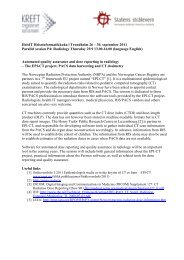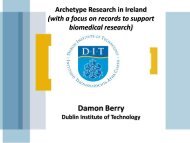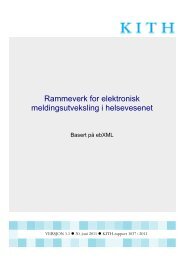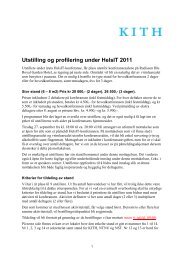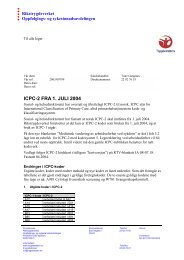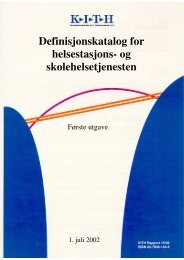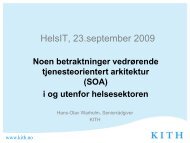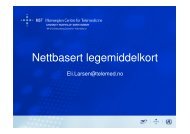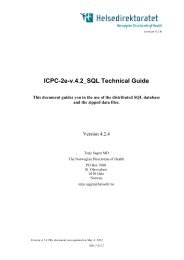The Logical Record Architecture (LRA) for health and social ... - KITHs
The Logical Record Architecture (LRA) for health and social ... - KITHs
The Logical Record Architecture (LRA) for health and social ... - KITHs
Create successful ePaper yourself
Turn your PDF publications into a flip-book with our unique Google optimized e-Paper software.
THE LOGICAL RECORD<br />
ARCHITECTURE (<strong>LRA</strong>)<br />
Laura Sato<br />
KITH Conference<br />
27 September 2011
Presentation Overview
NHS (Engl<strong>and</strong>) In<strong>for</strong>matics<br />
NHS Data St<strong>and</strong>ards & Products – develops <strong>and</strong><br />
delivers<br />
UK terminologies <strong>and</strong> classifications<br />
• Working with the IHTSDO (SNOMED CT) <strong>and</strong> the WHO (ICD)<br />
Message specifications<br />
• NHS Interoperability Toolkit (including HL7 V3 CDA)<br />
• National Programme <strong>for</strong> IT Message Implementation Manual (HL7<br />
V3)<br />
Data st<strong>and</strong>ards <strong>for</strong> centralised data collections <strong>and</strong><br />
population analyses<br />
• NHS Data Dictionary
NHS In<strong>for</strong>matics (continued)<br />
Currently with a dual reporting role within the<br />
agency called NHS Connecting <strong>for</strong> Health, as well<br />
as the Department of Health In<strong>for</strong>matics Directorate<br />
in Engl<strong>and</strong><br />
Major NHS organisational changes are currently under<br />
discussion<br />
• In principle, NHS data st<strong>and</strong>ards will fall under the<br />
responsibility of a future body called the NHS<br />
Commissioning Board<br />
• Organisational details are currently in development
<strong>LRA</strong> – Addressing gaps<br />
INTEROPERABILITY EFFICIENCY STANDARDS QUALITY
<strong>LRA</strong> Governance
Some <strong>LRA</strong> Design Principles<br />
‘Driven by’ clinical <strong>and</strong> patient data requirements<br />
Adopt, adapt or create anew in that order of<br />
preference<br />
Adopt existing international st<strong>and</strong>ards, national<br />
st<strong>and</strong>ards <strong>and</strong> local st<strong>and</strong>ards in that order of<br />
preference<br />
Begin requirements discussions following an<br />
‘environment scan’ of currently available st<strong>and</strong>ards on<br />
a given subject
Development process<br />
Build up the detailed<br />
architecture<br />
iteratively, through<br />
well-understood<br />
(testable) use cases
Relationship to st<strong>and</strong>ards
<strong>LRA</strong> <strong>and</strong> Technical St<strong>and</strong>ards<br />
<strong>The</strong> <strong>LRA</strong> con<strong>for</strong>ms to:<br />
ISO/EN 13606:1 (Reference Model)<br />
ISO 21090 (<strong>health</strong>care in<strong>for</strong>matics data types)<br />
<strong>The</strong> <strong>LRA</strong> makes maximal use of the SNOMED CT<br />
clinical concept model / hierarchy<br />
Currently, the <strong>LRA</strong> uses XML <strong>and</strong> Object Modelling<br />
Group (OMG) st<strong>and</strong>ards (UML, OCL) <strong>for</strong> both<br />
requirements <strong>and</strong> technical data models
Not a st<strong>and</strong>ard itself<br />
• Multiple ways of ‘con<strong>for</strong>ming’ to a logical architecture in<br />
physical systems (not con<strong>for</strong>mance-testable)<br />
• <strong>The</strong> <strong>LRA</strong> does not dictate physical codes, field lengths, what data is<br />
m<strong>and</strong>atory / optional, how it should be displayed / messaged, etc.<br />
• <strong>The</strong> <strong>LRA</strong> proposes meaning <strong>and</strong> structure <strong>for</strong> reference in data<br />
interpretation when sharing between systems<br />
• Intended as a practical view or bridge between independent<br />
st<strong>and</strong>ards (professional, technical), each with its own<br />
community of practice / scope of authority, rate of change<br />
• Currently, there is no overarching national governance across all<br />
<strong>health</strong> in<strong>for</strong>matics st<strong>and</strong>ards development
<strong>The</strong> <strong>LRA</strong> <strong>and</strong> Professional<br />
St<strong>and</strong>ards<br />
• A reference <strong>for</strong> initial input (when developing a new<br />
st<strong>and</strong>ard)<br />
• A way of making new st<strong>and</strong>ards accessible to a broad EHR<br />
implementation community<br />
• A bridge<br />
• Between pre-existing <strong>and</strong> new st<strong>and</strong>ards<br />
• E.g. NICE guidelines, NHS contracts, RCP-developed st<strong>and</strong>ards, etc.<br />
• Between professional <strong>and</strong> technical st<strong>and</strong>ards<br />
• A guide <strong>for</strong> how to implement professional st<strong>and</strong>ards<br />
• A way of assuring that st<strong>and</strong>ards operate at a common level of<br />
detail
<strong>LRA</strong> Discharge Summary Project<br />
Objective<br />
13<br />
To propose detailed definitions <strong>for</strong> meaning <strong>and</strong><br />
electronic data structure <strong>for</strong> improved<br />
communications to support<br />
continuing care<br />
improved technical communication between hospitals<br />
<strong>and</strong> general practice in<strong>for</strong>mation systems
General Review Notes <strong>for</strong> Discharge<br />
14<br />
Summary Requirements (1 of 2)<br />
<br />
Data content requirements to support continuing care were<br />
prioritised, particularly from the Discharge Summary receivers’<br />
perspectives (e.g. Patients, carers, family doctors, community<br />
services, etc.)<br />
Other types of data use were secondary<br />
<br />
Based on input regarding what patients <strong>and</strong> clinicians would<br />
like to see in Discharge Summaries in the future, providing a<br />
target <strong>for</strong> in<strong>for</strong>mation systems development design, planning<br />
<strong>and</strong> migration
General Review Notes <strong>for</strong> Discharge<br />
Summary Requirements (2 of 2)<br />
15<br />
• Encoded data (using the SNOMED Clinical Terminology) is proposed<br />
wherever appropriate to enable automated support <strong>for</strong>:<br />
– authoring (supporting fast <strong>and</strong> legible clinical record-keeping)<br />
– interpreting (e.g. <strong>for</strong> alerts or decision support)<br />
– updating (e.g. in systems receiving new data about the patient in the<br />
Discharge Summary that should be added to their patient records)<br />
– reporting (e.g. <strong>for</strong> research, operations management or other<br />
analyses)<br />
• NOTE: <strong>The</strong> SNOMED Clinical Terminology will in future be the only clinical<br />
terminology st<strong>and</strong>ard supported on a national basis (<strong>for</strong> maintenance, etc.) in the<br />
UK (starting April 2013).
Illustrative Data Display Example<br />
16 6. All Current Diagnoses at Discharge (6 recorded)<br />
DIAGNOSIS<br />
DATE DIAGNOSIS<br />
MADE<br />
PERSON<br />
RESPONSIBLE<br />
TREATMENT<br />
SPECIALTY<br />
DATE OF FIRST<br />
PRESENTATION<br />
Osteoarthritis of knee ‐ right 10‐Sep‐2009 Mr Greg Cross Orthopaedics May‐2009<br />
A complication of<br />
Fractured knee‐cap –right<br />
17‐Jun‐2006 Mr. Greg Cross Orthopaedics 16‐Jun‐2006<br />
Anaemia 02‐Oct‐2008 Dr. Jane Anderson General Practice 25‐Sep‐2008<br />
COPD‐Chronic obstructive pulmonary<br />
disease<br />
07‐Aug‐2006 Dr. Jane Anderson General Practice Jun‐2006<br />
Post‐operative pneumonia 08‐Nov‐2009 Mr. Jeremy Jones Respiratory Medicine 08‐Nov‐2009<br />
A complication of<br />
Primary cemented total knee 06‐Nov‐2006 Mr. Greg Cross Orthopaedics<br />
replacement –right<br />
Hypotension 09‐Nov‐2009 Mr. Greg Cross Orthopaedics 09‐Nov‐2009<br />
Sensorineural hearing loss –left Jun‐2002 Dr. Anne Bond Otolaryngology Jan‐2002
Requirement: Diagnoses at Discharge (1 of 6)<br />
17<br />
Business Description<br />
<br />
<br />
<br />
Business<br />
A description of a diagnosis that is present at Definition, the time of<br />
discharge. Multiple diagnoses may be recorded.<br />
references<br />
Diagnoses are ‘labels <strong>for</strong> communication which after<br />
consideration include all relevant diseases, disorders <strong>and</strong><br />
syndromes’ (from Headings <strong>for</strong> Communicating Clinical<br />
In<strong>for</strong>mation from the Personal Health <strong>Record</strong>: A Position Paper,<br />
Crown Copyright June 1998).<br />
<strong>The</strong> level of detail provided in this description is at the author’s<br />
discretion.
Requirement: All Diagnoses Current at Discharge<br />
(2 of 6)<br />
18<br />
Requirement References (that this data is needed in the<br />
Discharge Summary):<br />
<br />
<br />
Professional<br />
guideline<br />
A Clinician’s Guide to <strong>Record</strong> St<strong>and</strong>ards – Part reference 2: St<strong>and</strong>ards<br />
<strong>for</strong> the structure <strong>and</strong> content of medical records <strong>and</strong><br />
communications when patients are admitted to hospital<br />
(Academy of Medical Royal Colleges, October 2008).<br />
Requirement <strong>for</strong> ‘a summary of the key diagnosis made during<br />
the Patient’s admission’ from 2011/12 St<strong>and</strong>ard Terms <strong>and</strong><br />
Conditions <strong>for</strong> Acute Hospital Services (Department of Health,<br />
April 2011).
Requirement: All Diagnoses Current at Discharge<br />
(3 of 6)<br />
19<br />
Proposed Data Values: Coded expression including Diagnosis<br />
name <strong>and</strong> other descriptors, qualifiers or status modifiers. <strong>The</strong><br />
intent is to use codes wherever applicable (to allow automated<br />
record updates <strong>and</strong> analyses), but where authors want to add<br />
free text annotation, this should also be supported. Where no<br />
appropriate code exists, this value should be free text. (Note<br />
that free text data would not be accessible to automated<br />
interpretation / analysis, retrieval, etc.).
Requirement: All Diagnoses Current at Discharge<br />
(4 of 6) – Proposed [encode-able] Data Values<br />
<br />
<br />
<br />
<br />
<br />
<br />
Name of diagnosis<br />
Site<br />
Laterality<br />
<br />
Episode<br />
<br />
<br />
<br />
<br />
Left or right, but not left <strong>and</strong> right<br />
First episode<br />
New episode<br />
Old episode<br />
Ongoing episode<br />
Clinical Course<br />
<br />
<br />
<br />
Acute<br />
Chronic<br />
Transitory<br />
Severity<br />
<br />
<br />
<br />
Mild<br />
Moderate<br />
Severe<br />
Description of<br />
possible data<br />
values<br />
<br />
Status (assumed to cover both the degree of<br />
certainty <strong>and</strong> the presence/absence of conditions<br />
of significance to diagnostic/comorbidity<br />
labelling):<br />
Known present<br />
Known absent<br />
Suspected<br />
NOT suspected<br />
Definitely/confirmed present<br />
Definitely NOT present/excluded/ruled out<br />
Probably/possibly present<br />
Probably NOT present<br />
20
Requirement: All Diagnoses Current at Discharge<br />
(5 of 6)<br />
21 Likely data<br />
source<br />
Data Source: Copied from previous inpatient record entry<br />
Data Use: In<strong>for</strong>mation <strong>for</strong> patients <strong>and</strong> care providers, updates to the patient’s<br />
primary or shared care records, use in primary care decision support<br />
Description of<br />
algorithms<br />
use<br />
Note: <strong>The</strong> values proposed <strong>for</strong> clinical severity are those currently in use in UK<br />
GP systems. <strong>The</strong>se values may be encoded to support efficient <strong>and</strong> readable<br />
human record-keeping, but further guidance <strong>and</strong> training is likely necessary to<br />
enable very precise <strong>and</strong> consistent clinical interpretations. Designers of decision<br />
support systems must apply discretion about the use of this data based on the<br />
reliability of its interpretation. Some clinical specialties may have fully-specified<br />
severity scoring frameworks, <strong>and</strong> these may be referenced in the <strong>LRA</strong> in future<br />
versions.
Requirement: All Diagnoses Current at Discharge<br />
(6 of 6)<br />
22<br />
Examples:<br />
Illustrative data<br />
Acute myocardial infarction, first, confirmed presentexamples<br />
<br />
<br />
<br />
<br />
<br />
Carcinoma of hepatic flexure, probably present, first episode<br />
Diabetes mellitus<br />
Asthma<br />
Chronic obstructive pulmonary disease<br />
RULED OUT ulcerative colitis<br />
Available Data St<strong>and</strong>ards: SNOMED CT<br />
(with free text option by exception)<br />
Reference to<br />
data st<strong>and</strong>ard<br />
that meets the<br />
requirement
Current content project – Discharge<br />
Summary<br />
• Sponsored by Prof J. G. Williams (Royal College of Physicians) <strong>and</strong> John<br />
Thornbury (Worcestershire Health ICT)<br />
• Initiated in October 2010, to complete in Nov. 2011<br />
• Full draft requirements specification available now<br />
• Draft technical models <strong>for</strong> a prioritised content subset now available<br />
<strong>for</strong> testing <strong>and</strong> comment<br />
• Publication November 2011
More in<strong>for</strong>mation<br />
Comments Questions<br />
• www.connecting<strong>for</strong><strong>health</strong>.nhs.uk/systems<strong>and</strong>servic<br />
es/data/lra<br />
• Email: cfh.lra-admin@nhs.net
THANK YOU!



